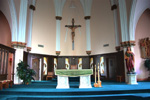Churches and Sanctuaries
History
In any study of religion, it is vital to understand how and why a certain religion worships, prays, or simply gathers the way it does. Most major religions are identified with a certain place: Christians attend churches; Jews worship in synagogues; Muslims pray together in mosques; Buddhists gather in meditation in temples or Zen centers. And while almost any practicing member of a religion will tell you that the religion is not all about being in a particular physical place, these buildings and rooms can reveal a great deal about that religion. These sacred spaces are a physical representation of that religion and its adherents, and how they choose to represent themselves to the world can prove fascinating.
In addition, many spaces reflect traditions or actions connected to or even necessary to the practice of that religion. Why are there bowls of water inside the doors of a Roman Catholic church? What do the domes on top of Eastern Orthodox churches mean? Why are there two separate seating areas in Orthodox synagogues? Why are the cushions in a Buddhist center arranged the way they are? Is there a reason every mosque faces the same direction? How a religion chooses to arrange its sacred spaces can tell an observer a great deal about the religion or, more importantly, inspire someone to ask questions and learn more.
This is a general breakdown of religions represented in Pennsylvania, showing how their different spaces of worship or gathering reflect their faith or beliefs. It should be noted that this is a general list, and is not absolutely complete.
Photos
Click the thumbnails for larger images. Photo by Rebecca Krieger unless otherwise noted.

Chancel at St. John the Evangelist Roman Catholic Church

Statue of a seated Buddha at Blue Mountain Lotus Society